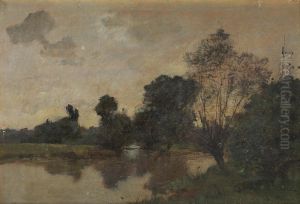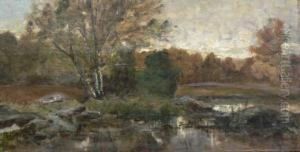Gaston Pelouse Paintings
Gaston Pelouse was a French landscape painter born on July 29, 1849, in Pierrelaye, France. His full name was Léon-Gaston Pelouse, and he became well-known for his pastoral and forest scenes, often capturing the traditional countryside of France with a delicate and realistic touch. Pelouse was part of the Barbizon school, a movement that emphasized naturalistic and often plein-air painting, which was a precursor to Impressionism.
Pelouse studied under the academic painter Pierre Galland and exhibited his works at the Paris Salon for the first time in 1875. His landscapes were appreciated for their attention to detail, atmospheric perspective, and the way he captured the changing light within natural settings. He was particularly adept at depicting the forests of Fontainebleau, a subject that many Barbizon painters were drawn to. His style was characterized by a harmonious color palette and a refined handling of texture, which gave his canvases a serene and inviting quality.
The artist enjoyed a successful career, winning medals at the Paris Salon in 1879, 1880, and 1882. He was awarded the Legion of Honor in 1880, a prestigious recognition in France. Pelouse’s works became part of important public collections, and he held a significant influence on landscape painting in France during his time.
Despite his success, Pelouse faced personal tragedy with the early death of his son, Léon, who was also a promising painter. This loss deeply affected him, and his work subsequently conveyed a more somber mood. Pelouse continued to paint and exhibit his work until his death on August 31, 1916, in L'Isle-Adam, a commune in the northwestern suburbs of Paris. His legacy lives on in the museums that house his works, including the Musée d'Orsay in Paris, and in the continued appreciation for the Barbizon school’s contribution to the development of landscape painting.

